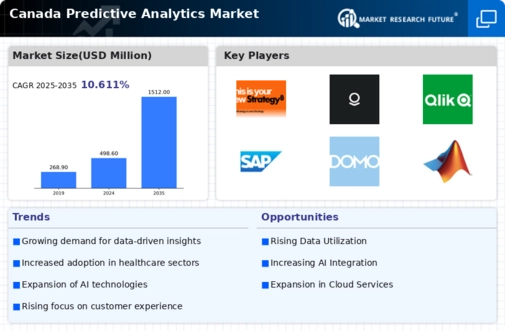Rising Importance of Customer Experience
In the Canadian market, the emphasis on enhancing customer experience is a key driver for the predictive analytics market. Organizations are increasingly utilizing predictive analytics to gain insights into customer preferences and behaviors, allowing them to tailor their offerings accordingly. This trend is particularly pronounced in the retail and e-commerce sectors, where understanding customer journeys can lead to improved satisfaction and loyalty. The market is projected to expand by approximately 22% over the next few years, as businesses recognize the competitive advantage that comes from leveraging data to enhance customer interactions. By employing predictive analytics, companies can anticipate customer needs and deliver personalized experiences, thereby fostering stronger relationships and driving growth in the predictive analytics market.
Regulatory Compliance and Risk Management
The need for regulatory compliance and effective risk management increasingly shapes the predictive analytics market in Canada. Organizations are under pressure to adhere to stringent regulations regarding data privacy and security, which necessitates the use of predictive analytics to identify potential risks and ensure compliance. Industries such as finance and healthcare are particularly affected, as they must navigate complex regulatory landscapes. The market is expected to grow at a rate of around 15% annually, as companies invest in analytics solutions that not only enhance compliance but also mitigate risks. This focus on regulatory adherence indicates a broader trend towards responsible data usage, which is likely to drive the adoption of predictive analytics tools and technologies across various sectors.
Advancements in Machine Learning Algorithms
Advancements in machine learning algorithms significantly influence the predictive analytics market in Canada. These innovations enable organizations to process and analyze large datasets more efficiently, leading to more accurate predictions and insights. As machine learning techniques evolve, they become increasingly accessible to businesses of all sizes, fostering a culture of data utilization. The integration of sophisticated algorithms allows for real-time analytics, which is crucial for industries such as finance and healthcare, where timely decisions can have substantial impacts. Furthermore, the market is expected to witness a growth rate of around 20% annually, driven by the continuous improvement of these technologies. This evolution not only enhances the capabilities of predictive analytics but also broadens its application across various sectors, thereby propelling the market's expansion.
Increased Investment in Data Infrastructure
In Canada, the predictive analytics market is bolstered by increased investment in data infrastructure. Organizations are recognizing the necessity of robust data management systems to support their analytics initiatives. Investments in cloud computing, data warehousing, and data governance are becoming commonplace as companies seek to harness the full potential of their data. This trend is particularly evident in sectors such as retail and telecommunications, where data plays a pivotal role in understanding consumer behavior. The market is projected to grow by approximately 30% over the next few years, driven by these infrastructure enhancements. As businesses prioritize data quality and accessibility, the predictive analytics market is likely to benefit from a more conducive environment for analytics-driven strategies, ultimately leading to improved business outcomes.
Growing Demand for Data-Driven Decision Making
The predictive analytics market in Canada is experiencing a notable surge in demand as organizations recognize the value of data-driven decision making. Businesses across various sectors, including finance, healthcare, and retail, are leveraging predictive analytics to enhance operational efficiency and improve customer experiences. According to recent estimates, the market is projected to grow at a CAGR of approximately 25% over the next five years. This growth is fueled by the need for organizations to analyze vast amounts of data to derive actionable insights. As companies strive to remain competitive, the integration of predictive analytics into their strategic frameworks becomes essential. This trend indicates a shift towards a more analytical approach, where data serves as a cornerstone for informed decision-making, thereby driving the predictive analytics market forward.
























Leave a Comment